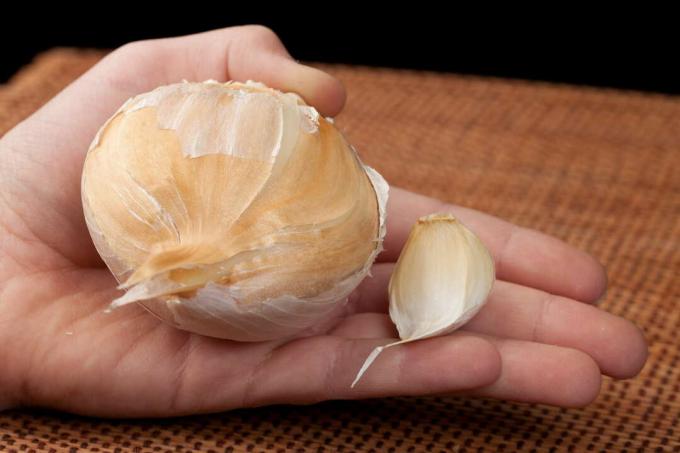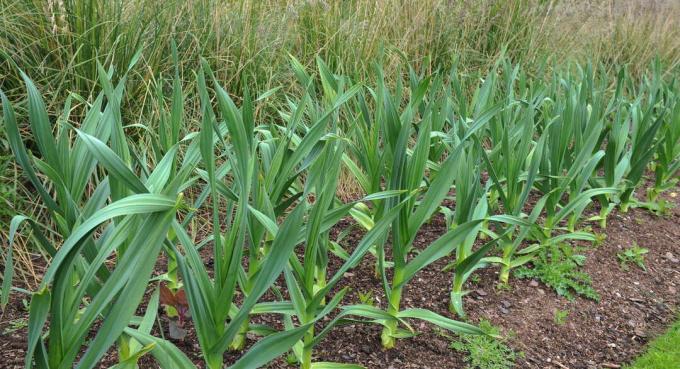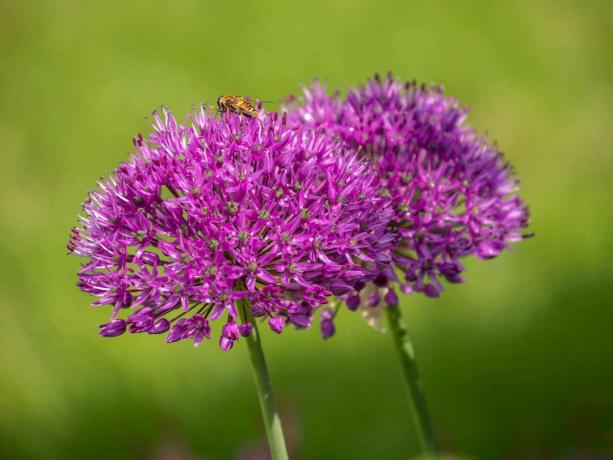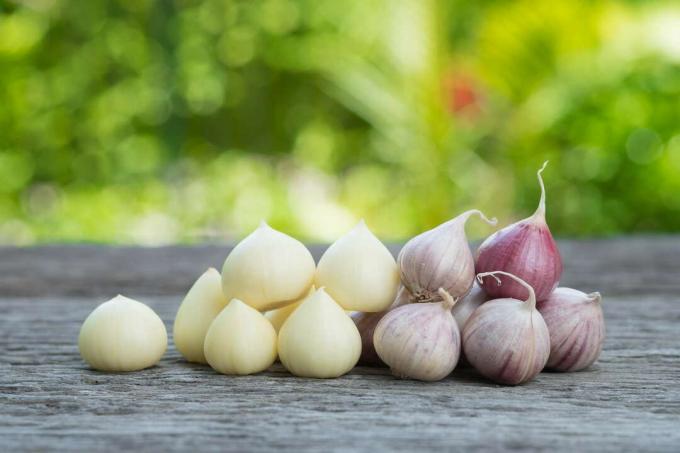For a long time, the relative of the leek was almost forgotten. We show how to successfully grow elephant garlic in your own garden.

Considerable, isn't it, how big does a single clove of elephant garlic appear compared to a conventional clove of garlic? The giant garlic looks similar to leek, but forms garlic-shaped tubers. Here you can find out how you can grow this mild alternative and rarity in your garden.
The elephant garlic or giant garlic (Allium ampeloprasum subsp. ampeloprasum) is actually not closely related to our usual one garlics (Allium sativum). However, both are members of the bulbous family (Alliaceae) and look amazingly similar under the ground, because the elephant garlic also develops many small onions throughout the year, which are then harvested in autumn. The tubers reach the size of a regular onion with a diameter of about seven centimeters, but have a milder taste than the garlic commonly used in kitchens. However, the foliage of the giant garlic is more like its close relative, the
leek (Allium ampeloprasum). The elephant garlic flowers from June white, pink or reddish in the typical Allium-Balls of flowers on long stalks. The plant reaches a height of up to 150 centimeters. Here are 6 tips for growing elephant garlic in your own garden.contents
- 1. The right location for elephant garlic
- 2. The right planting time for elephant garlic
- 3. Fertilize and care for elephant garlic
- 4. Harvest elephant garlic
- 5. Propagating elephant garlic
- 6. Drying and preserving elephant garlic
1. The right location for elephant garlic
Elephant garlic prefers to grow on permeable, sandy soil with a good supply of nutrients. Sandy loamy soil is ideal for this, which can also store enough water for growth. Sunny and warm locations promote the development of the large tubers. In winter, the ground should not freeze completely, a reasonably protected bed also protects the elephant garlic from freezing. In addition, there should be no other bulbous plants near the plant, otherwise the risk of diseases increases significantly. It is also suitable as a subsequent crop onions (Allium cepa), leeks or garlic.

Elephant garlic goes particularly well with umbellifers (Apiaceae) how carrots (Daucus carota), fennel (Foenicum vulgare) or parsnips (Pastinaca sativa), because here he drives away the carrot fly (Chamaepsila rosae), whose maggot eats through the tasty root vegetables.
2. The right planting time for elephant garlic
The individual cloves are planted about 10 centimeters deep in the ground with the tip pointing upwards in autumn or spring from March. The distance between the individual bulbs should be about 20 centimeters. Cloves planted in the fall can root before winter and have a better start to the season next year. However, a very cold winter can also kill off the little plants, which is why it is always worth saving a few cloves for spring.
3. Fertilize and care for elephant garlic
A compost addition in the spring is usually sufficient for the elephant garlic. If no compost is available, it is worth giving an organic slow-release fertilizer like ours Plantura organic universal fertilizer. Since the plants are somewhat sensitive to drought, the culture should be mulched regularly to ensure a closed soil surface. The water is held better in the soil, and the mulch decomposes over time and provides valuable nutrients. Finally, with a layer of mulch, weed seeds have a much harder time outdoing elephant garlic. Further Benefits of Mulching you'll find here. In the event of prolonged drought, the leek relatives should be watered regularly. Once the giant garlic starts to pucker and turn brown, it no longer needs additional water.
4. Harvest elephant garlic
Harvesting elephant garlic is very easy. It starts in July and can last until autumn. Once the plants have wilted and turned brown, the tubers can be dug up whole. If you want to store the tubers, it is best to let them dry with the soil. Further information and tips can also be found in our special article Harvesting and storage of garlic.

5. Propagating elephant garlic
On the outside of the tuber there are often tiny onions, but they can also be planted out and then within a year to normal sized single cloves and a year later to giant bulbs develop. The cloves can also be planted out again and usually form a spherical shape next to the tuber Allium-Flowers out on a long peduncle. However, these flowers are usually sterile and do not form seeds from which one could grow elephant garlic again. On the other hand, the variety can be preserved with vegetative propagation through tubers and cloves and there is no risk of crossbreeding with other types of onions.
6. Drying and preserving elephant garlic
The small spring onions that sit on the outside of the bulbs of elephant garlic can be pickled just like pearl onions or used fresh. Freshly dug tubers are tied together by the herb and hung up in a dry place, protected from the weather. Alternatively, you can put the fresh cloves in oil, for example together with tomatoes. The dried tubers are best kept dry and in the dark with soil and the protective white skin at about 5 to 10 °C, otherwise the cloves will sprout like potatoes. They can then be kept throughout the winter and can therefore be used continuously in the kitchen.
Unfortunately, elephant garlic is very rarely found in specialty markets, so it is easier to buy the onions on the Internet. A biological supply source is the Bioland-Hof Jeebel, which offers the rarity on its website biogartenversand.de.

If you are now curious and would like to know more about garlic and its relatives, take a look at our article 11 curious facts about garlic stop by and let yourself be surprised.



